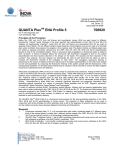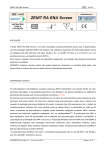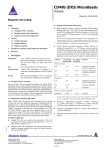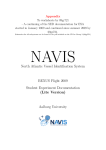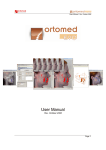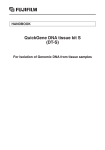Download QUANTA LiteTM dsDNA
Transcript
QUANTA PlexTM SLE Profile 8 708910 For In Vitro Diagnostic Use CLIA Complexity: High Intended Use The QUANTA Plex™ SLE Profile 8 is a fluorescent immunoassay for the semi-quantitative detection of Sm, RNP, SS-A 60, SS-A 52, SS-B, Scl-70, Jo-1, Ribosome P and Chromatin autoantibodies in human serum. The presence of these antibodies can be used in conjunction with clinical findings and other laboratory tests to aid in the diagnosis of systemic lupus erythematosus and related connective tissue diseases; Sjögren's Syndrome, Scleroderma and Polymyositis. Summary and Explanation of the test Antinuclear autoantibodies (ANA) are found in a wide variety of connective tissue diseases. Testing for ANA on HEp-2 cells or an ANA ELISA serves as a sensitive screening assay.1 While ANA testing is an excellent screening test for systemic lupus erythematosus (SLE), a negative result virtually rules out active SLE2, it is by no means a specific test. Follow-up testing is typically done on sera that yield positive ANA results. Nine of the more common autoantibodies react specifically with Sm, RNP, SS-A 60, SS-A 52, SS-B, Scl-70, Jo-1, Ribosome P and Chromatin autoantigens. Autoantibodies to these autoantigens can contribute significant diagnostic and prognostic information when evaluating patients suspected of a variety of connective tissue diseases such as SLE2, Sjögren's Syndrome3, Scleroderma4 and Polymyositis 5. Antibodies to Sm, RNP, SS-A 52, SS-A 60, Ribosome P and Chromatin are found in patients with SLE1,6,7; anti-SS-A 52, SS-A 60 and SS-B are found in people with Sjögren’s syndrome3,8; anti-Scl-70 and SS-A 52 in patients with scleroderma4,9; and anti-Jo-1 and SS-A 52 in patients with polymyositis.5,8,9 A variety of methods including ELISA, Ouchterlony double diffusion, Western blot and passive agglutination have been used to detect antibodies to Sm, RNP, SS-A 60, SS-A 52, SS-B, Scl-70, Jo-1, Ribosome P and Chromatin. The fluorescent immunoassay (FIA) technique employed by the QUANTA Plex™ SLE Profile 8 is objective, semi-quantitative, and can be conveniently used to simultaneously test large numbers of patients. Semi-quantitative results are obtained for each autoantibody reactivity. Principles of the Procedure Native Sm, RNP, SS-B, Scl-70, SS-A 60 and Chromatin from calf thymus, recombinant Jo-1 and SS-A 52, and a 23 amino acid synthetic peptide from the Ribosome P sequence are each bound to different, fluorescently “colored” beads. It has been reported that autoantibodies to both SS-A 60 and SS-A 52 are diagnostically important.8,9 The nine different antigen coated beads, as well as an anti-IgG control bead, are mixed together and put into wells of a microwell plate under conditions that preserve the antigens in their reactive state. Pre-diluted controls and diluted patient sera are added to separate microwells, allowing any Sm, RNP, SS-A 60, SS-A 52, SS-B, Scl-70, Jo-1, Ribosome P and Chromatin autoantibodies present to bind to the immobilized antigen. Then an anti-human IgG conjugated to a fluorescent probe is added to each microwell. A second incubation allows the anti-human IgG fluorescent conjugate to bind to any patient autoantibodies that have become attached to the antigen on the beads. The samples are then measured in the Luminex™ 100 or 200 flow analyzer. This flow analyzer can discriminate the color of each bead from the others as well as measure the fluorescent intensity of the conjugate on each bead.10 The conjugate’s fluorescent intensity is proportional to the amount of labeled anti-human IgG bound to the patient autoantibodies on the bead. Autoantibodies can be semi-quantitated by comparing the fluorescent intensity of the patient sample with the fluorescence of the corresponding Calibrator. The anti-IgG-coated control bead is included in each microwell to ensure that false negative results due to operational errors are detected. Reagents 1. 2. 3. 4. 5. 6. 7. Polystyrene microwell plate 12 (1 x 8) microwell strips (stamped pink in color) with holder, containing beads of 10 different colors. Each of the colored beads is coated with a different purified antigen (Sm, RNP, SS-A 60, SS-A 52, SS-B, Scl-70, Jo-1, Ribosome P, Chromatin and anti-IgG), in a foil package containing desiccants QUANTA Plex™ Negative Control, 1 vial of buffer containing preservative and human serum with no human IgG antibodies to Sm, RNP, SS-A 60, SS-A 52, SS-B, Scl-70, Jo-1, Ribosome P and Chromatin antigens in the SLE Profile 8, prediluted, ready to use, 1.2mL SLE Profile 8 Calibrator, 1 vial of buffer containing preservative and human serum antibodies to Sm, RNP, SS-A 60, SS-A 52, SS-B, Scl-70, Jo-1, Ribosome P and Chromatin antigens, prediluted, ready to use, 1.2mL SLE Profile 8 Positive Control, 1 vial of buffer containing preservative and human serum antibodies to Sm, RNP, SS-A 60, SS-A 52, SS-B, Scl-70, Jo-1, Ribosome P and Chromatin antigens, prediluted, ready to use, 1.2mL HRP Sample Diluent, 1 vial – colored pink, containing Tris-buffered saline, Tween 20, protein stabilizers and preservatives, 50mL Fluorescently labeled IgG Conjugate (goat), anti-human IgG (fc specific), 1 amber vial – lyophilized powder, containing buffer, protein stabilizers and preservatives. Refer to the Methods section for reconstitution instructions. QUANTA Plex™ Conjugate Diluent, 1 vial - colored pink, containing buffer, protein stabilizers and preservatives, 7mL 1 Warnings 1. 2. 3. 4. 5. WARNING: The HRP Sample Diluent and controls contain a chemical (0.02% chloramphenicol) known to the State of California to cause cancer. All human source material used in the preparation of controls for this product has been tested and found negative for antibody to HIV, HBsAg, and HCV by FDA cleared methods. No test method however can offer complete assurance that HIV, HBV, HCV or other infectious agents are absent. Therefore, the QUANTA Plex™ Negative Control and the SLE Profile 8 Calibrator and Positive Control should be handled in the same manner as potentially infectious material.11 Sodium Azide is used as a preservative. Sodium Azide is a poison and may be toxic if ingested or absorbed through the skin or eyes. Sodium azide may react with lead or copper plumbing to form potentially explosive metal azides. Flush sinks, if used for reagent disposal, with large volumes of water to prevent azide build-up. Use appropriate personal protective equipment while working with the reagents provided. Spilled reagents should be cleaned up immediately. Observe all federal, state and local environmental regulations when disposing of wastes. Precautions 1. 2. 3. 4. 5. 6. 7. 8. This product is for In Vitro Diagnostic Use. Substitution of components other than those provided in this kit may lead to inconsistent results. All controls are kit lot number specific. Adaptation of this assay for use with certain automated liquid sample processors was shown to yield equivalent results to those obtained using the manual procedure. It is the responsibility of each laboratory to validate that their automated procedure yields test results within acceptable limits. A variety of factors influence the assay performance. These include the starting temperature of the reagents, the ambient temperature, the accuracy and reproducibility of the pipetting technique, the reproducibility of the mixing technique, the Luminex™ 100 or 200 flow analyzer used to measure the results and the length of the incubation times during the assay. Careful attention to consistency is required to obtain accurate and reproducible results. Strict adherence to the protocol is recommended. Incomplete resealing of the zip-lock pouch containing microwell strips and desiccants will result in antigen degradation and poor precision. Unacceptably low fluorescence may be observed following multiple uses from a single bottle of fluorescent conjugate over a period of time. It is important to follow all recommended fluorescent conjugate handling procedures to prevent this occurrence. Chemical contamination of the fluorescent conjugate can result from improper cleaning or rinsing of equipment or instruments. Residues from common laboratory chemicals such as formalin, bleach, ethanol, or detergent will cause degradation of the fluorescent conjugate over time. Thoroughly rinse all equipment or instruments with distilled or deionized water after the use of chemical cleaners/disinfectants. Storage Conditions 1. 2. Store all the kit reagents at 2-8°C. Do not freeze. Reagents are stable until the expiration date when stored and handled as directed. Unused microwell strips with antigen-coated beads should be securely resealed in the foil pouch containing desiccants and stored at 2-8°C. Specimen Collection This procedure should be performed with a serum specimen. Microbially contaminated, heat-treated, or specimens containing visible particulates should not be used. Grossly hemolyzed or lipemic serum should not be used. Following collection, the serum should be separated from the clot. CLSI (formerly NCCLS) Document H18A3 recommends the following storage conditions for samples: 1) Store samples at room temperature no longer than 8 hours. 2) If the assay will not be completed within 8 hours, refrigerate the sample at 2-8°C. 3) If the assay will not be completed within 48 hrs, or for shipment of the sample, freeze at -20°C or lower. Frozen specimens must be mixed well after thawing and prior to testing. Procedure: Materials provided 1 1 1 1 1 1 1 SLE Profile 8 microwell plate, 12 (1 x 8) microwell strips (stamped pink in color), with holder 1.2mL prediluted QUANTA Plex™ Negative Control, ready to use 1.2mL prediluted SLE Profile 8 Calibrator, ready to use 1.2mL prediluted SLE Profile 8 Positive Control, ready to use 50mL HRP Sample Diluent Bottle of lyophilized Fluorescent Conjugate (goat), anti-human IgG 7mL QUANTA Plex™ Conjugate Diluent Additional Materials Required But Not Provided Sheath Fluid for Luminex™ 100 or 200 flow analyzer Micropipet to deliver 5 and 500µL Disposable micropipet tips Test tubes for patient sample dilutions, 1 to 4mL volume Distilled or deionized water 2 Luminex™ 100 or 200 flow analyzer 8-channel Electronic pipet to deliver 5, 45 and 50µL or Automated pipetter/diluter Using the Luminex™ 100 or 200 Flow Analyzer 1. 2. 3. 4. 5. 6. 7. 8. See the user's manual provided with the Luminex™ for detailed instructions on running the Luminex™ 100 or 200 flow analyzer and the Luminex™ Integrated System (IS) Version 2.0 or higher software program. For additional information and for troubleshooting problems with this assay, contact INOVA Diagnostics, Inc. Technical Services at the address or telephone number found on the last page of the Direction Insert. Brief Luminex™ 100 or 200 flow analyzer operating instructions are provided below. Calibrate the Luminex™ using the Calibration and Control beads supplied by Luminex Corporation at least once per month and verify that calibration was successful. In addition, calibrate the Luminex™ if the delta calibration temperature is more than 3 degrees, if the assay controls are out of range or as needed. The Luminex™ takes 30 minutes to warm-up after being turned on. When the warm-up period is completed, perform the prime, alcohol flush and wash operations recommended by the manufacturer. Using IS Version software, load the "QP SLE Profile 8" template and ensure that all lot information is correct. If necessary, update the lot information. The parameters are as follows. The bead colors are SS-A 60 = 17, SS-A 52 = 19, SS-B = 7, Sm = 8, RNP = 9, Scl-70 = 11, Jo-1 = 12, Ribosomal-P = 13, Chromatin = 14, control anti-IgG = 42. The events per bead are 50, the sample size is 50μL, the flow rate is 60μL/minute (fast), and the gate is 7500 to 17000. The median values are used for the Median Fluorescent Intensity (MFI). Input the sample names either manually or by clicking on "Load Pa List". Load the plate into the XY platform of the Luminex™. Run the Luminex™ by clicking the "Start Plate" button. When finished for the day, perform the sanitize and soak operations prior to turning the instrument off. Method: Before you start 1. 2. 3. 4. 5. 6. 7. For programming information for automated equipment, contact INOVA Diagnostics, Inc. Technical Services. Turn on the Luminex™ 100 or 200 flow analyzer, ensure that it is warmed-up, and perform all daily maintenance operations as previously described. If necessary, calibrate the instrument and verify that the calibration was successful. Bring all reagents and patient samples to room temperature (20-26oC) and mix them well. If the anti-human IgG fluorescent conjugate has not been reconstituted, add 6mL of QUANTA Plex™ Conjugate Diluent to the amber vial containing the lyophilized powder and swirl the container for approximately 30 seconds to dissolve the contents. The reconstituted fluorescent conjugate is stable for 3 months at 2-8°C. Do not freeze. Make sure that the sheath fluid container in the Luminex™ is filled with Sheath Fluid available from Luminex Corporation. Prepare a 1:101 dilution of each patient sample by adding 5µL of each serum to 500µL of HRP Sample Diluent, then vortex to thoroughly mix the solution. Diluted samples must be used within 8 hours of preparation. DO NOT DILUTE the QUANTA Plex™ Negative Control, SLE Profile 8 Calibrator and Positive Control. Determination of the presence or absence of Sm, RNP, SS-A 60, SS-A 52, SS-B, Scl-70, Jo-1, Ribosome P and Chromatin antibodies using arbitrary units requires one microwell each for the QUANTA Plex™ Negative Control and SLE Profile 8 Positive Control, two microwells for the SLE Profile 8 Calibrator and one microwell for each patient sample. It is recommended that samples be run in singleton. Assay procedure 1. 2. 3. 4. All reagents must be brought to room temperature (20-26°C) prior to beginning the assay. Place the required number of microwells/strips in the holder. Immediately return unused strips to the pouch containing desiccants and seal securely to minimize exposure to water vapor and light. Add 45µL of HRP Sample Diluent to each microwell that will contain a patient sample. Do not add HRP Sample Diluent to the first four microwells, as these will contain the QUANTA Plex™ Negative Control, the SLE Profile 8 Calibrator (in duplicate), and the SLE Profile 8 Positive Control. Do not add the diluted patient samples to the microwells at this time. Maintain one of the following timing sequence when adding controls, samples, and conjugate to the microwells. Because the samples are read sequentially at a rate of approximately 1 sample every 19 seconds (or one 8-well strip in approximately 2½ minutes) by the Luminex™, the patient samples and also the conjugate must be added to the microwells at this rate to minimize any front to back assay variation. If the controls, samples, or the conjugate are added one at a time, stagger each addition of these to the next microwell by 19 seconds. If controls, samples, or the conjugate are added 8 at a time to a strip, stagger each addition of any of these to the next strip by 2 ½ minutes. Both of these timing schemes will take approximately 30 minutes for the addition of the samples to all 12 strips of an entire plate and will minimize front to back assay variation. Vortex, then add 50µL of each of the following: The pre-diluted QUANTA Plex™ Negative Control to 3 5. 6. 7. the first microwell, the SLE Profile 8 Calibrator to the second and third microwells, and the SLE Profile 8 Positive Control to the fourth microwell. An electronic pipet must be used when manually adding samples and mixing the beads. Use one of the timing sequences for adding the controls as described in step 3. Vigorously pipet at least 30μL of the QUANTA Plex™ Negative Control and SLE Profile 8 Calibrator and Positive Control up and down four times in order to mix the beads and the controls in each microwell. The 30-minute incubation time begins after adding the QUANTA Plex™ Negative Control into the first microwell. Immediately continue the assay by adding 5μL of diluted patient serum to the appropriate microwells (note: this makes a 1:1010 final dilution of the patient serum). Maintain the same timing sequence as used in step 4. Mix the diluted patient sample and the HRP Sample Diluent in the microwell by vigorously pipetting at least 30μL of the contents of the microwell up and down four times. Continue timing the incubation for 30 minutes from the time of the addition of the QUANTA Plex™ Negative Control. Place the microwell strips at room temperature, on a level surface, and away from direct sunlight for the remainder of the incubation period. At the end of the first incubation period, add 50μL of the fluorescent conjugate to each microwell and vigorously pipet at least 60μL of the contents of the microwell up and down four times. Maintain the same timing sequence for adding the conjugate that was used in steps 4 and 5. The conjugate should be removed from the bottle using standard aseptic conditions and good laboratory techniques. Remove only the amount of conjugate from the bottle necessary for the assay. TO AVOID POTENTIAL MICROBIAL AND/OR CHEMICAL CONTAMINATION, NEVER RETURN UNUSED CONJUGATE TO THE BOTTLE. Incubate the microwell strips for 30 minutes at room temperature, on a level surface, and away from direct sunlight. The incubation time begins after the first conjugate addition. Within one hour after completion of the 30-minute fluorescent conjugate incubation, read the SLE Profile 8 plate on the Luminex™ as detailed in the section above, “Using the Luminex™ 100 or 200 Flow Analyzer”. Quality Control 1. 2. 3. 4. 5. 6. The SLE Profile 8 Calibrator and Positive Control and the QUANTA Plex™ Negative Control should be run with every batch of samples to ensure that all reagents and procedures have performed properly. Note that since the SLE Profile 8 Calibrator and Positive Control and the QUANTA Plex™ Negative Control are prediluted, they do not control for procedural methods associated with specimen dilutions. Additional controls may be tested according to guidelines or requirements of local, state and/or federal regulations or accrediting organizations. Additional suitable control sera may be prepared by aliquoting pooled human serum specimens and storing them at < -20o C. In order for the test results to be considered valid, all of the criteria listed below must be met. If any of these are not met, the test should be considered invalid and the assay repeated. The value in Luminex Units (LU) of the Calibrator for each antigen is found on the box label for that kit. Refer to the formula in the Calculation of Results section to determine the LUs of the QUANTA Plex™ Negative Control and the SLE Profile 8 Positive Control. a. The value of the prediluted QUANTA Plex™ Negative Control must be <20 LU on each of the 9 antigens and between 10 and 50 LU on the anti-IgG bead. b. The value of the SLE Profile 8 Positive Control must be > 100 and < 300 LU on Sm, RNP, SS-A 60, SS-B Scl-70, Jo-1, Ribo-P and Chromatin antigens and must be > 50 and < 250 on the SS-A 52 antigen. The SLE Profile 8 Positive Control must be between 10 and 50 LU on the anti-IgG bead. c. The anti-IgG control bead is meant to ensure that false negative patient results due to operational errors are detected. The possibility exists that patient sample and/orconjugate was not added to the patient sample well if the patient sample’s anti-IgG bead is less than 3.0 LU and is negative on the other beads. In this case the patient should be re-tested to confirm the negative result. d. The user should refer to CLSI (formerly NCCLS) Document C24-A3 for additional guidance on appropriate QC practices. The QUANTA Plex™ Negative Control and the SLE Profile 8 Calibrator and Positive Control are intended to monitor for substantial reagent failure. If desired, a well with sample diluent but no serum can be run to confirm that the anti-IgG control bead will detect a well with no serum. This serum free control should be < 3.0 LU on the anti-IgG control bead and negative on all other beads. Calculation of Results The MFIs for all controls and patient samples for each antigen are first determined. The reactivity in LU of a given sample for each type of antigen can then be calculated by the following formula: Divide the MFI of the sample by the MFI of the SLE Profile 8 Calibrator for that antigen and multiply the result by the number of LU assigned to the SLE Profile 8 Calibrator for that antigen. The value in LUs of the SLE Profile 8 Calibrator for each antigen is found on the box label for that kit lot. The following example is for determining anti-Sm reactivity. Use the equivalent formula for each of the other antigens. Sample MFI for Sm Sample Value (in LU) = —————————————————— x Sm Calibrator value (in LU) Sm Calibrator MFI 4 The sample can then be classified according to the table below. LU Negative <20 Weak Positive 20-49 Moderate Positive 50-100 Strong Positive >100 Reactivity is related to the quantity of autoantibody present on the bead in a non-linear fashion. While increases and decreases in patient antibody concentrations will be reflected in a corresponding rise or fall in fluorescent reactivity, the change is not proportional (i.e. a doubling of the antibody concentration will not double the reactivity). In addition, the amount of total IgG in a patient's serum affects the measured MFI. If a more accurate quantitation of patient autoantibody is required, the sample should be run on a quantitative test. Interpretation of Results The FIA is very sensitive to technique and is capable of detecting small differences in patient populations. Each laboratory should establish its own normal range based upon its own techniques, controls, equipment and patient population according to their own established procedures. It is suggested that the results reported by the laboratory should include the statement: “The following results were obtained with the INOVA QUANTA PlexTM SLE Profile 8. Values obtained with different manufacturers’ assay methods may not be used interchangeably. The magnitude of the reported IgG autoantibody levels cannot always be correlated to an endpoint titer.” Limitations of the Procedure 1. 2. 3. 4. 5. 6. 7. The presence of immune complexes or other immunoglobulin aggregates in the patient sample may cause an increased level of non-specific binding and produce false positives in this assay. Not all SLE, Sjögren's syndrome, scleroderma or polymyostis patients are positive for Sm, RNP, SS-A 60, SS-A 52, SS-B, Scl-70, Jo-1, Ribosome P or Chromatin autoantibodies. Results of this assay should be used in conjunction with clinical findings and other serological tests. Failure to adequately mix the controls and/or the diluted serum samples with the preserved beads in the plate may yield higher %C.V. values than those typically found in ELISA assays. After the half-hour incubation with the fluorescent conjugate, there is approximately a 10% further increase in fluorescence for every additional half-hour of incubation time. The performance characteristics of this assay have not been established for matrices other than serum. Failure to maintain consistent reagent addition timing may result in increased front-to-back assay variation. Expected Values The ability of the QUANTA PlexTM SLE Profile 8 test to detect Sm, RNP, SS-A 60, SS-A 52, SS-B, Scl-70, Jo-1, Ribosome P and Chromatin antibodies was evaluated by comparison to commercially available ELISA tests from INOVA Diagnostics, Inc. Results of the ELISAs and each of the QUANTA Plex™ ENA Profile 6 and each of the QUANTA Plex™ SLE Profile 8 tests were determined to be positive if the patient sample was 20 units or greater and negative if less than 20 units. Normal Range 485 samples from normal blood donors were run on the QUANTA Plex™ SLE Profile 8 test. Included in the table below for each antigen are the percent of these samples that were negative, the average and standard deviation of this group, the highest value in the group, and the number of standard deviations above the average that was used for the cutoff between negative and positive. Antigen % Negative Average LU Standard Deviation Highest Value # of SD above Avg. Sm 99.4 3 2.4* 130 7.1 RNP 99.6 2 3.5 59 5.1 SS-A 52 99.0 5 3.5* 226^ 4.3 SS-A 60 99.4 3 4.4* 213^ 3.9 SSB 99.2 3 2.8 44 6.1 Scl-70 100 3 1.2 14 14.2 Jo-1 100 1 0.6 5 31.7 Ribosome P 100 4 1.9 13 8.4 Chromatin 99.0 5 4.8 66^ 3.1 *Patients with LUs over 100 units were not figured into the calculation of the standard deviation. ^ These results came from the same patient. Comparison between SLE Profile 8, ENA Profile 6 and ELISAs n=437 SS-A^ ENA Profile 6 Negative Positive SS-A 52 Negative 326 35* SLE Profile 8 92.0% the same Positive 0 76 ^This SS-A contains both SS-A 52 and SS-A 60 *29 of these were positive by SS-A 60 Luminex n=437 SS-A^ ENA Profile 6 Negative Positive SS-A 60 Negative 326 30* SLE Profile 8 93.1% the same Positive 0 81 ^This SS-A contains both SS-A 52 and SS-A 60 *24 of these were positive by SS-A 52 Luminex 5 n=437 SS-A^ ENA Profile 6 Negative Positive SS-A 52 or 60 Negative 326 6* SLE Profile 8 98.6% the same Positive 0 105 ^This SS-A contains both SS-A 52 and SS-A 60 *4 positive by SS-A^ ELISA n=437 Sm ENA Profile 6 Negative Positive Sm 361 1* SLE Profile 8 Negative 95.0% the same Positive 21** 54 * Negative by ELISA; **12 positive by ELISA n=437 Scl-70 ENA Profile 6 Negative Positive Scl-70 Negative 368 15* SLE Profile 8 95.9% the same Positive 3** 51 *8 positive by ELISA; **0 positive by ELISA n=412 Ribosome P ELISA Negative Positive Ribosome P 383 8 SLE Profile 8 Negative 97.6% the same Positive 2 19 n=437 SS-B ENA Profile 6 Negative Positive SS-B Negative 406 1* SLE Profile 8 99.8% the same Positive 0 30 * This is negative by ELISA n=437 RNP ENA Profile 6 Negative Positive RNP 341 4* SLE Profile 8 Negative 98.6% the same Positive 2** 90 *3 positive by ELISA; **0 positive by ELISA n=437 Jo-1 ENA Profile 6 Negative Positive Jo-1 Negative 412 5* SLE Profile 8 98.9% the same Positive 0 20 * 0 were positive by ELISA n=412 Chromatin ELISA Negative Positive Chromatin 313 26 SLE Profile 8 Negative 92.2% the same Positive 6 67 Positive and Negative Percent Agreement Prof 6 - Prof 6 + Positive Negative Total N = 437 Both - Both + Prof 8 + Prof 8Agreement Agreement Agreement SS-A* 326 105 0 6 95% 100% 98.6% SS-B 406 30 0 1 97% 100% 99.8% Sm 361 54 21 1 98% 95% 95.0% RNP 341 90 2 4 96% 99% 98.6% Scl-70 368 51 3 15 77% 99% 95.9% Jo-1 412 20 0 5 80% 100% 98.9% N = 412 Ribo P** 383 19 2 8 70% 99% 97.6% Chrom** 313 67 6 26 72% 98% 92.2% *SS-A bead compared to SS-A 52 and SS-A 60 beads; **compared to ELISA Precision and Reproducibility Inter-assay and Intra-assay variation. For inter-assay variation, a number of samples were assayed in 6 tests run on different days. The variation in two different samples for each specific test is listed in the table below. For intra-assay variation, a number of samples were assayed 7 times each on a single assay. The variation in two different samples for each test specificity is listed in the table below. Inter-assay variation Antigen Average LU % C.V. Sm 64 6% Sm 38 5% RNP 74 5% RNP 33 9% SS-A 52 158 14% SS-A 52 101 8% SS-A 60 108 6% SS-A 60 75 4% SS-B 127 7% SS-B 83 6% Scl-70 56 15% Scl-70 31 13% Jo-1 50 10% Jo-1 69 14% Ribo-P 73 7% Ribo-P 98 9% Chromatin 65 11% Chromatin 84 8% Intra-assay variation Antigen Average LU Sm 61 Sm 38 RNP 64 RNP 27 SS-A 52 167 SS-A 52 91 SS-A 60 119 SS-A 60 69 SS-B 149 SS-B 76 Scl-70 64 Scl-70 48 Jo-1 42 Jo-1 59 Ribo-P 65 Ribo-P 105 Chromatin 61 Chromatin 80 6 % C.V. 9% 2% 10% 11% 5% 5% 5% 6% 2% 3% 3% 6% 6% 3% 10% 4% 7% 6% References 1. 2. 3. 4. 5. 6. 7. 8. 9. 10. 11. 12. 13. von Mühlen CA and Tan E: Autoantibodies in the Diagnosis of Systemic Rheumatic Diseases. Seminars in Arthritis and Rheumatism 24: 323-358, 1995. Tan EM, et al.: The 1982 Revised Criteria for the Classification of Systemic Lupus Erythematosus. Arthritis and Rheumatism 25: 1271-1277, 1982. Jonsson R, Haga HJ and Gordon TP: Current concepts on diagnosis, autoantibodies and therapy in Sjögren's syndrome. Scand J Rheumatol 29: 341-348, 2000. Giordano M, Valentini IG, Migliaresi S, et al: Different antibody patterns and different prognoses in patients with scleroderma and various extent of skin sclerosis. J Rheumatol 13: 911-916, 1986. Arnett, J, et al.: The Jo-1 antibody system in myositis: relationships to clinical features and HLA. J Rheumatol 8: 925, 1981. Bonfa E, et al.: Association between lupus psychosis and anti-Ribosome P protein antibodies. N Engl J Med 317: 265, 1987. Burlingame RW and Cervera R: Anti-chromatin (anti-nucleosome) autoantibodies. Autoimmunity Reviews 1: 321-328, 2002. McCauliffe DP, Wang L, Satoh M, Reeves WH and Small D: Recombinant 52 kDa Ro(SSA) ELISA detects autoantibodies in Sjögren's syndrome sera that go undetected by conventional serologic assays. J Rheumatol 24: 860-866, 1997. Frank MB, V McCubbin, E Trieu, Y Wu, DA Isenberg, IN Targoff: The association of anti-Ro52 autoantibodies with myositis and scleroderma autoantibodies. J Autoimmun 12:137-142, 1999. Martins TB, Burlingame R, von Mühlen CA, et al: Evaluation of multiplexed fluorescent microsphere immunoassay for detection of autoantibodies to nuclear antigens. Clin Diagn Lab Immunol 11: 10541059, 2004. Biosafety in Microbiological and Biomedical Laboratories. Centers for Disease Control/National Institutes of Health, 5th edition, 2007. CLSI (NCCLS). Procedures for the Handling and Processing of Blood Specimens; Approved Guideline-Third Edition. CLSI Document H18-A3, Vol. 24(38), 2004. National Committee for Clinical Laboratory Standards. Feb 1999. Statistical quality control: Principles and definitions; Approved Guideline- 3rd edition C24-A3, Vol. 26, No. 25. Manufactured By: INOVA Diagnostics, Inc. 9900 Old Grove Road San Diego, CA 92131 United States of America Authorized Representative in the EU: Medical Technology Promedt Consulting GmbH Altenhofstrasse 80 D-66386 St. Ingbert, Germany Tel.: +49-6894-581020 Fax.: +49-6894-581021 www.mt-procons.com Technical Service 628910 888-545-9495 July 2007 Revision USA2 7







